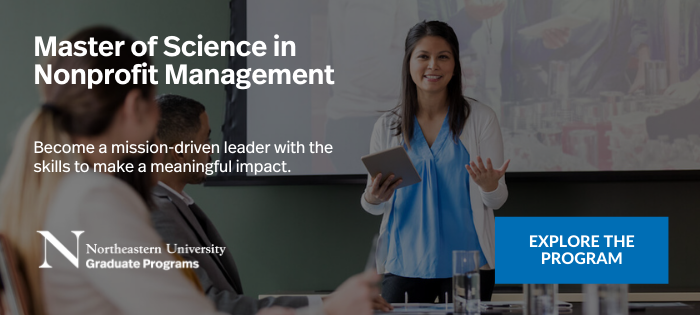In the United States, there are more than 1.6 million organizations registered as 501(c) tax-exempt nonprofit corporations. By law, each is required to have a board of directors. With an estimated average board size of 15, there are approximately 24 million nonprofit board members in the country. Considering that’s more than the entire population of New York, you might be wondering who are these board members, and what are their responsibilities?
First, it’s essential to understand the significant differences between a for-profit corporate board of directors and a nonprofit board of directors. Corporate board members are guardians of shareholders’ interests, while their nonprofit counterparts work to meet the needs of those served by the organization’s work. The common ground is delivering a clear mission and organizational values while providing sound governance and oversight. Whether you’re currently working in the nonprofit sector, considering a career change, or thinking about joining a nonprofit board—it’s essential to understand how a board works and what practices make their work effective.
Advance Your Career in Nonprofit Management
Become a mission-driven leader with the skills to make a meaningful impact.
Effective Nonprofit Boards Provide a Constant Compass
From providing quality healthcare to advocating for those in need, purpose-driven organizations are actively involved in most aspects of society. They face ongoing challenges, including funding, staffing, legal compliance, and consistent delivery of programs and services. A highly effective board successfully minimizes potential risks and maximizes short- and long-term opportunities.
Learn more about the types of nonprofits in the U.S.
“Many nonprofits underutilize their board,” says James Gorske, lecturer in Northeastern University’s Master of Science in Nonprofit Management (MSNPM) program. “It’s essential that organizations know how to make the most of their board’s talents and have professional processes in place that make a board member’s experience constructive and positive.”
Eight Basic Responsibilities of a Nonprofit Board
While every nonprofit has a unique mission and organizational structure, boards typically share common, basic responsibilities. Nonprofit boards typically take responsibility for these eight key tasks:
- Setting an actionable mission and an inspiring vision for the organization
- Hiring a chief executive, supporting their efforts, and evaluating their performance
- Partnering with key staff to create short- and long-term plans, monitoring results, and modifying when needed
- Ensuring the effectiveness of programs and services
- Helping to secure operating funds and providing ongoing financial oversight
- Managing and improving board performance
- Meeting or exceeding legal and ethical standards and expectations
- Maximizing stakeholder and community support
Get more detail on nonprofit board responsibilities.
The Role and Obligations of Individual Board Members
Under nonprofit corporation law, board members have legal obligations defined as “duty of care,” “duty of loyalty,” and “duty of obedience.” While these terms may sound archaic, they are well-established tenets of good governance.
According to the National Council of Nonprofits, duty of care instructs board members to ensure prudent use of all assets, including facility, people, and goodwill. It describes the care that a responsible individual would take under similar circumstances or the reasonable care one must employ when acting as a guardian of the organization.
Duty of loyalty directs board members to make decisions in the organization’s best interest, not in the interest of the individual board member or any other individual or for-profit entity. The goal is to recognize, disclose, and avoid any conflicts of interest. It also dictates that board members cannot leverage insider information for personal gain. Duty of loyalty implies full allegiance when making decisions affecting the organization.
Public trust is essential to nonprofits. Donors and stakeholders must have full confidence that all funds are being used to advance the organization’s mission. Duty of obedience requires board members to perform their responsibilities in a way that is faithful to the stated mission—while following all laws and internal rules, policies, and regulations.
Examples of Specific Ongoing Duties
In addition to the three primary fiduciary duties outlined above, here are some of the activities that individual board members typically engage in:
- Staying up-to-date with the organization’s programs, services, and policies
- Following developments in the field that may inform decision making
- Attending board and committee meetings as well as special events
- Reviewing meeting agendas, minutes, and materials related to discussions
- Serving on committees or task forces and taking on special assignments as needed
- Participating in reviews of financial statements
- Referring board nominees who could make significant contributions to the work of the board and the organization
- Making personal financial contributions to the organization
- Informing others about the organization
Overcoming Board Challenges
Three main factors help a board to be more effective. First, the right board members must be in place. Second, an effective chief executive should be leading the organization. Lastly, both the board and the chief executive must know their responsibilities and be dedicated to ongoing communication.
“The relationship between a CEO and the organization’s board is huge,” Gorske says. “It’s an ongoing dance. “A CEO has to want and value the work of the board, and the board needs to trust the CEO’s role and not micromanage daily affairs.”
Identifying the right board members can be difficult. Board members need to be fully committed to the organization’s mission and must also bring needed skills and balance to the overall board. A good board member also needs to have time to devote to board responsibilities and must be open to taking on new challenges as the organization adapts to inevitable external and internal changes.
Developing Stronger Nonprofit Boards
Nonprofit boards are changing as regulatory requirements become more stringent and societal needs evolve. Nonprofit boards have often been perceived as a bastion of wealthy men. Historically, they’ve also not been particularly diverse. While many boards require their members to be donors, this requirement isn’t as critical as it once was. Many nonprofits now find that they need more from board members than deep pockets, as governance issues and legal compliance grow in complexity. Gorske says, “rubber stamp boards are going the way of the dinosaur.”
“Boards are putting a bigger emphasis on diversity as well as better reflecting all stakeholders, including opening more board seats to those served,” adds Greg Smith, lecturer in Northeastern University’s Master of Science in Nonprofit Management program. Gorske also sees heavy-hitter boards often trading off engagement and talent. “It’s problematic when all your board members are so high up that they’re used to having people do things for them. Sometimes you just need to roll up your sleeves and get things done. That’s what we teach our students to do [at Northeastern].”
Learning to be a Better Board Member
One of the big questions facing nonprofit executives and boards is who holds the responsibility for educating board members? How do people learn how to become an effective board member? Smith believes the answer is both the organization and the board.
“It’s a give and take,” Smith says. “Boards often struggle with just what their role is. Executive teams need to give boards the organizational knowledge they need to understand what their job is.” Gorske agrees, noting, “One of the exercises that some students do in the program is to actually create an onboarding manual for new board members. It gives them a real-world perspective on what board members need to do their job.”
“On the other side of the coin,” Smith adds, “an effective board educates and keeps each other up-to-date on governance issues and requirements.”
Advanced education also plays a major role. “Northeastern’s MSNPM program is designed to help create the next generation of nonprofit leaders,” Gorske says. “Many of our students come to the program from the field. They’ve seen the importance of working effectively with boards and the scope of the program allows them to come out and know exactly what a board should do and what the relationship should be.”
An Advanced Degree in Nonprofit Management Can Help You Drive Board Success and Advance Your Career
If you’re currently working within the nonprofit sector, you’ve likely experienced the importance of a board and the organization they serve, working in concert to get the job done. Northeastern University’s Master of Science in Nonprofit Management program is dedicated to deepening your knowledge of all aspects of nonprofit leadership, including governance and regulation. An advanced degree can bring you new opportunities to grow your career. If you have a passion for pursuing a career in purpose-driven organizations, an advanced degree has become a clear advantage as the field becomes more competitive.
Learn more about the advantages of earning your MS in Nonprofit Management at Northeastern University.







Related Articles
Master’s in Project Management or an MBA: What’s the Difference?
6 Project Management Trends Emerging in 2023
Master’s Degree Comparison: Sports Leadership vs. Sports Management